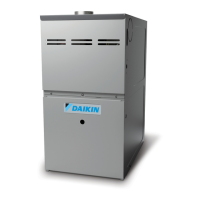29
SERVICING
1. Check for 120 volts from Line 1 (Hot) to Line 2 (Neu-
tral) at the ignition control. No voltage, check the door
switch connections and wire harness for continuity.
2. Check for 24 volts from W to C terminal on the
ignition control. No voltage. Check transformer, room
thermostat, and wiring.
If you have 24 volts coming o the transformer but
receive approximately 13 volts on the terminal board
between (C) and (R), check for blown fuse.
3. Check for 120 volts to the induced draft blower by
measuring voltage between Pin 1 (on the 2-pin con-
nector) and Line (Neutral) on the control board. No
voltage, replace ignition control.
4. If voltage is present in Steps 1 through 3 and the
induced draft blower is operating, check for 120 volts
to the ignitor during the preheat cycle. Measure volt-
age between Pin 2 (on the 2-pin connector) and Line
(Neutral) on the control board. No voltage, check
pressure switch.
5. After the ignitor warmup time, begin checking for 24
volts to the gas valve. Voltage will be present for seven
seconds only if proof of ame has been established.
A ame sensing device is used in conjunction with the igni-
tion control module to prove combustion. If proof of ame is
not present the control will de-energize the gas valve and
“retry” for ignition or lockout.
The following drawings illustrate from a bottom view, the ap-
proximate distances for the ignitor and ame sensor to the
gas in shot burner. You will note they are in the main burner
stream, not in the carry over ports as shown in the following
gure.
-
-
1. Disconnect the blue ame sensor wire from the
sensor.
2. Connect a micro-amp meter in series with this wire
and the sensor terminal.
3. Place the unit into a heating cycle.
4. As soon as ame is established a micro-amp reading
should be evident once proof of ame (micro-amp
reading) is established, the hot surface ignitor will be
de-energized.
5. The Integrated Ignition controls will have 1 to 4 mi-
cro-amps. If the micro-amp reading is less than the
minimum specied, check for high resistance wiring
connections, sensor to burner gap, dirty ame sen-
sor, or poor grounding.
6. If absolutely no reading, check for continuity on all
components and if good - replace ignition control
module.
-

